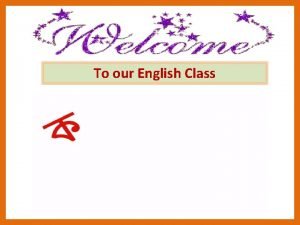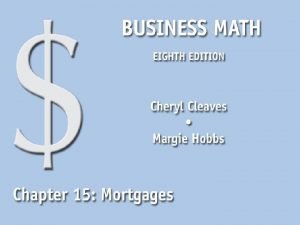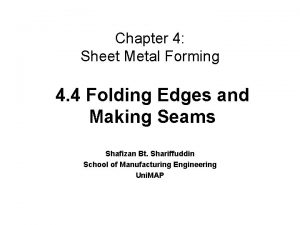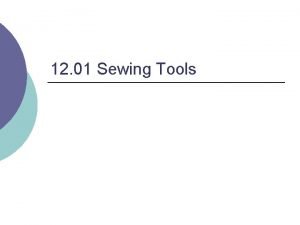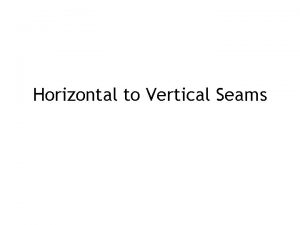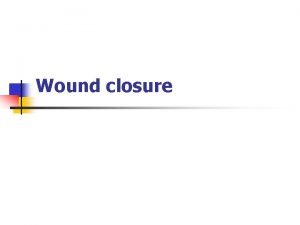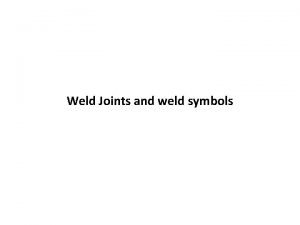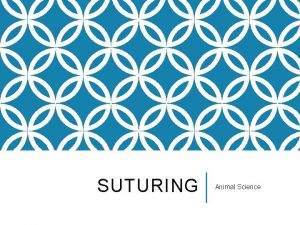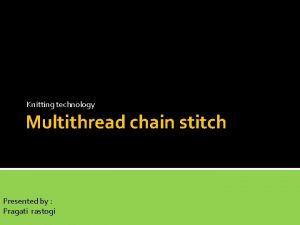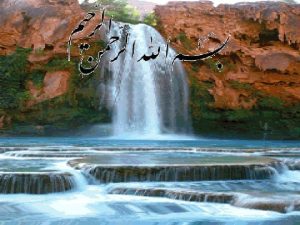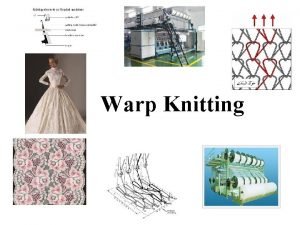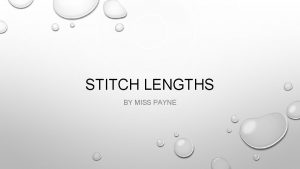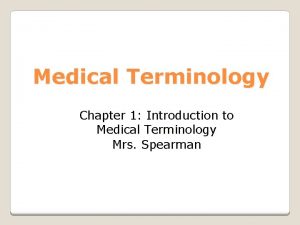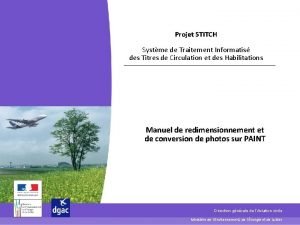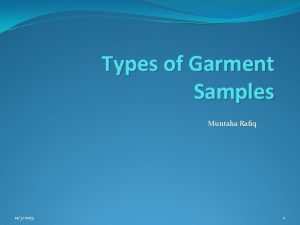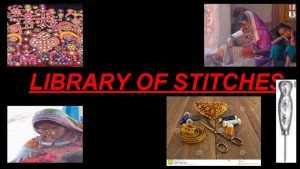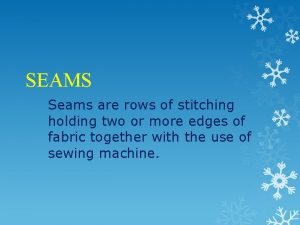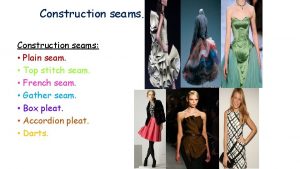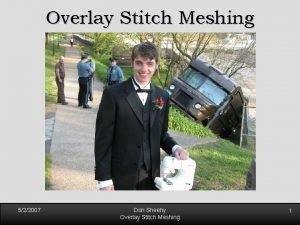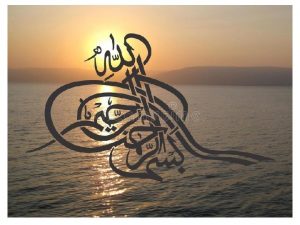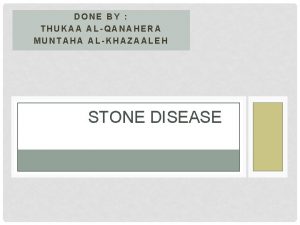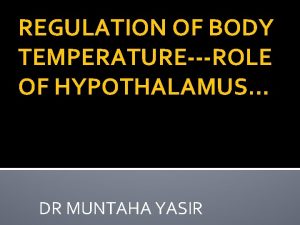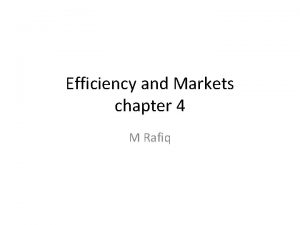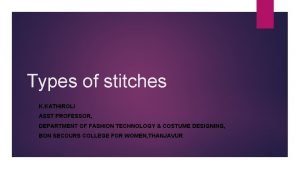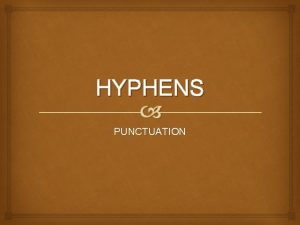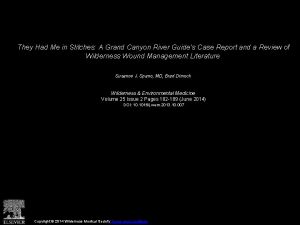Stitches and Seams Muntaha Rafiq Stitch A stitch






















- Slides: 22

Stitches and Seams Muntaha Rafiq

Stitch: A stitch is a configuration of the interlacing of a sewing thread in a specific repeated unit. Stitching: A stitching consists of a series of stitches embodied in a material for ornamental purposes or finishing an edge or both.

Stitch classes: There are six basic stitch classes. ØClass 100(Chain stitch) ØClass 200(Hand stitch) ØClass 300(Lock Stitch) ØClass 400( Multi thread chain stitch) ØClass 500(Over edge stitch) ØClass 600(Covering chain stitch)

Chain stitch: Mechanism of stitch formation: Chain stitch class 100 is formed with one or more needle threads that form a loop on the upper side of the fabric. There is no lower thread. The single thread chain stitch is interloping formation that can be recognized by a flat straight thread formation similar in appearance to the lock stitch on the face of fabric and loop on the underside. The needle carries the thread through the fabric and a lopper holds the thread and forms a loop for the needle thread. The loop formation allows good elongation and stretch and makes unraveling easy if the correct thread end is pulled. Most widely used stitch types in this class are Single thread chain stitch 101 Single thread Blind stitch 103 Saddle stitch

Uses: ØSingle thread chain stitches are mostly used for temporary operations like basting pockets closed. ØClass 101 is mostly used for closing bags of sugars and pet foods. ØAttachment of paper tags, buttons and sewing of some types of button holes. ØFor spot tacks that hold the pant cuffs in place ØBar tacks for reinforcement of stressed areas ØClass 103 is used for blind hemming ØSaddle stitches are used in pleated garments for ornamental stitches.

Hand stitch: ØIt includes stitch types 201, 202, 203, 204 and 205. ØClass 200 consists of stitches that are formed by hand. ØClass 205 is formed with a type of hand running machine. ØHand stitches are usually formed by a single line of thread passing in and out of the material.

Uses: ØIt is used for lined jackets and tailored garments. ØClass 205 is used on the front edges of men’s jackets and coats for aesthetic purpose.

Lock Stitch class 300: ØThe lock stitch is most commonly used and easiest to understand. ØMechanism: ØLock stitch mechanism includes two thread to form a stitch, a needle thread that feeds from the top and a lower thread that feed from the bobbin. ØA rotary hook or shuttle catches the needle thread loop as it passes around the bobbin and interlock the two threads ØIf a lock stitch breaks the whole line of stitches will not unravel. ØLock stitch sometimes referred to as plain or straight stitch. ØClass 301 uses the least amount of thread and produces the fastest stitches. This gives the best hand allows stitches to blend into fabric surface. Because stitch formation is same on both sides it can be used for top stitching along collar and cuff edges.

Multi thread chain stitch Class 400: It includes stitch types 401, 402, 403, 404, 405, 406 and 407. Mechanism: Multithread chain stitch requires one or more needle threads that form loops as they pass through the fabric and inter loop with the looper thread on the underside. This type has many characteristics that are similar to the 100 class but is more durable and used extensively on apparel. The major difference is that the 400 class stitches require an upper needle thread and a looper to carry the lower thread and form a loop underside the fabric.

401 Type: ØIt is two thread chain stitch and its appearance is same as 101 but it is more durable. Uses: ØFor side seam of woven tee shirt or jeans ØElastic attachment with waistband ØDecorative stitches on belts or other garment components. 402 Type or cording stitch: ØIt uses two needle thread that produce two parallel rows of stitching on the face of fabric. A looper thread travels between the two needle threads on back of fabric creating a crease between needle threads on the face. Uses: ØMostly used in sportswear where a crease needs to be maintained ØOn the back of gloves

406&407 ØThese are known as bottom cover stitches. These are used to cover seams or unfinished edges on the inside of garment and to keep them flat. ØTo form hems on knitted garments ØAttach bindings in men’s brief

Class 500 -Overedge stitch The over edge often called over lock, serge, overcast or merrow. All 500 class machines trim the edge of the fabric just in front of needle. It is not appropriate to use in attaching a patch pocket or for the topstitching as it would trim along the stitch line. Mechanism: Over edge machines must have a pair of knives and three stitch forming devices, a needle to carry the thread through the fabric, a looper to carry the thread from the needle on the bottom and a looper to over the edge of material on the top.

Types 503, 504 and 505 are used for serging. Serging is the process of stitching along the cut edge of a single ply to prevent raveling. Class 512 and 514 are known as mock safety stitches and formed with two needle and two loopers. Class 515, 516 and 519 are known as safety stitches. It is a combination of over edge stitch and 401 chain stitch. The chain stitch that closes the seam is locked up by another row of tight over edge stitches. These are used for shirts, jackets, blouses and jeans.

Class 600 -Cover stitch: These are called flat lock or flat seam stitches. These are more complex version of class 400 and used primarily on knits and lingerie. Machine producing class 600 are more efficient and fast, operating at 9000 rpm. Mechanism: Stitch is formed by two or more needle loops passing through the material, inter looping on the underside and interlocking on the upper side. A spreader or cover thread finger carriers the cover thread across the surface of the fabric between the needles. Used in knit garments to cover raw edges and to avoid raveling They may be used for attaching flat knit or ribbed knit collars.

Stitch Properties: Stitch size has three dimensions, length, width, depth. Stitch Length: ØIt is specified as number of stitch per inch (Spi) and can be an indicator of quality. This is also referred as stitch density. Stitch length is determined by the amount of the fabric that is advanced under the needle between penetrations. ØHigh spi means short stitches and low spi means longer stitches. ØLonger stitches are less durable and have low quality due to more abrasion and snagging. Men’s dress shirt with 22 spi is considered high quality as compared to same shirt made with 8 spi. Stitch Consistency: It is the uniformity with which each stitch is formed in a row of stitches.

Stitch Depth: It is the distance between the upper and lower surface of stitch. Stitch width: It refers to horizontal span covered in formation of one stitch or single line of stitching.

Stitching Classes: Edge finishing: It is a stitching that encompasses a cut edge or provides a finish for a single ply of fabric with a folded edge. Stitches from any of the classes can be used depending on type of fold or and placement of stitching. Uses: Tee shirt hemming, edge finishing Ornamental Stitching: It may be used on a single ply for decorative purpose. It can be done anywhere on the garment except edges. It includes decorative stitching on jean pockets, embroidered logos and pin tucks down the front of a shirt. Uses: Decorative stitch on jean pockets Decorative stitching with cording insert Raised stitching

Seams: Seams are formed when two or more pieces of fabric are joined by stitches. Seam length: It is the total distance covered by a continuous series of stitches such as side seam. Seam Allowance: It is measured from the cut edge of the fabric to the main line of stitches. Seam Heading: It is the distance from the folded edge of the top ply to the first line of stitches. Seam Depth: It is the thickness of the seam

Seam Classes: Superimposed seams: It is formed by joining two or more pieces of fabric usually with seam allowance edges even and one piece superimposed over the second. These seams can be sewn with a lock stitch, chain stitch, over edge stitch or safety stitch. These can be used for side seams of dress slacks, skirts and blouses.

Lapped Seams: It is formed by two or more pieces of fabric joined by overlapping at the needle. Fabric pieces would extend both left and right from the overlapped area. It is largest class with 101 seam types These are used to attach front bands of shirts, side seams of tee shirts and side seams of jeans.

Bound seam: It is formed by sewing one piece of fabric or binding as it encompasses the edge of one or more pieces of fabric. There are only 18 types in this class. These are used to finish the edges of garments. Necklines, short sleeves on some styles of tee shirts and sleeve less tank tops may be finished with a binding. Bound seams may be sewn with lock stitch, chain stitch or cover stitch. But they never sewn with an over edge stitch because the knife will cut the binding.

Flat seam: ØIt is the smallest class with only six types. ØFormation of this seam occur by sewing together two butted pieces of fabric but not overlapping them. ØThe stitches are used from class 600. ØFlat seams are constructed to remain flat through care and wear. They are commonly used for seams of sweatshirts, lingerie and long underwear.
 Who are they
Who are they Rafiq's monthly mortgage payment
Rafiq's monthly mortgage payment Rafiq hasan
Rafiq hasan Slender tool attached in the needle clamp used for sewing
Slender tool attached in the needle clamp used for sewing Surgical staples
Surgical staples Episiotomy scissors diagram
Episiotomy scissors diagram Episiotomy indications
Episiotomy indications What is the folded edge on a sheet metal object
What is the folded edge on a sheet metal object Grooved joint in sheet metal
Grooved joint in sheet metal Takes out sewing mistakes
Takes out sewing mistakes Folded seam
Folded seam Vertical seams
Vertical seams Continuous stitch
Continuous stitch Welding symbol intermittent
Welding symbol intermittent Uninterrupted suture
Uninterrupted suture Stich 2
Stich 2 Stitch type 402
Stitch type 402 Baseball stitch classical cesarean
Baseball stitch classical cesarean Difference between tricot and raschel warp knitting machine
Difference between tricot and raschel warp knitting machine Stay stitch length
Stay stitch length Cyan o medical term
Cyan o medical term Sutura allgower
Sutura allgower Stitch aviation civile
Stitch aviation civile
